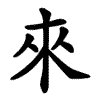來
- to come, to arrive;
- future, afterward;
Etymology
Originally a pictograph of grain (especially wheat or barley) with drooping heads, representing ripened crops.
In earliest forms, 來 depicted stalks of wheat.
Because the Old Chinese word for “come” was phonetically close to the word for “wheat,” the character was borrowed (假借) to mean “to come.”
To disambiguate, a new graph 麥 (맥, “barley/wheat”) was later coined by adding 夂 under 來, leaving 來 to carry primarily the verbal sense “to come.”
Semantic range:
- to come, arrive (오다);
- future, afterward (이후, 앞날);
- to bring about, cause;
- sometimes used as a suffix in compounds to denote futurity or continuity.
Usage in Korean
來年 (내년) — next year
未來 (미래) — future
來日 (내일) — tomorrow; also “future days”
後來 (후래) — afterward, later on
來往 (내왕) — to come and go, association
以來 (이래) — since (a certain time)
Words that derived from 來
Additional notes
In Confucian classics, 來 frequently marks future expectations or the continuity of ritual and virtue into later generations, emphasizing transmission from past to present to future.
In Daoist texts, 來 often embodies the natural unfolding of things yet to arrive, aligned with 無爲 (non-action) and trust in the flow of the Dao.
In Buddhist sutras, 來 is significant in expressions like 如來 (여래, “Thus Come One”), one of the titles of the Buddha, stressing the Buddha’s timeless presence: both having “come” into the world and being beyond coming and going.
